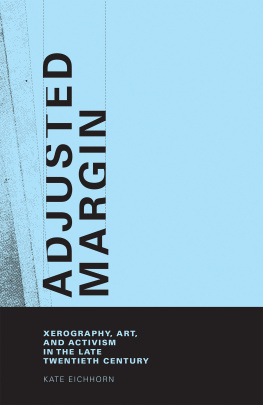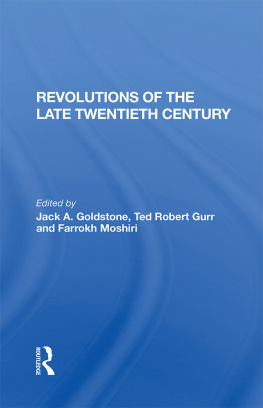Eichhorn - Adjusted Margin: Xerography, Art, and Activism in the Late Twentieth Century
Here you can read online Eichhorn - Adjusted Margin: Xerography, Art, and Activism in the Late Twentieth Century full text of the book (entire story) in english for free. Download pdf and epub, get meaning, cover and reviews about this ebook. year: 2016, publisher: MIT Press, genre: Romance novel. Description of the work, (preface) as well as reviews are available. Best literature library LitArk.com created for fans of good reading and offers a wide selection of genres:
Romance novel
Science fiction
Adventure
Detective
Science
History
Home and family
Prose
Art
Politics
Computer
Non-fiction
Religion
Business
Children
Humor
Choose a favorite category and find really read worthwhile books. Enjoy immersion in the world of imagination, feel the emotions of the characters or learn something new for yourself, make an fascinating discovery.
- Book:Adjusted Margin: Xerography, Art, and Activism in the Late Twentieth Century
- Author:
- Publisher:MIT Press
- Genre:
- Year:2016
- Rating:4 / 5
- Favourites:Add to favourites
- Your mark:
- 80
- 1
- 2
- 3
- 4
- 5
Adjusted Margin: Xerography, Art, and Activism in the Late Twentieth Century: summary, description and annotation
We offer to read an annotation, description, summary or preface (depends on what the author of the book "Adjusted Margin: Xerography, Art, and Activism in the Late Twentieth Century" wrote himself). If you haven't found the necessary information about the book — write in the comments, we will try to find it.
Eichhorn: author's other books
Who wrote Adjusted Margin: Xerography, Art, and Activism in the Late Twentieth Century? Find out the surname, the name of the author of the book and a list of all author's works by series.
Adjusted Margin: Xerography, Art, and Activism in the Late Twentieth Century — read online for free the complete book (whole text) full work
Below is the text of the book, divided by pages. System saving the place of the last page read, allows you to conveniently read the book "Adjusted Margin: Xerography, Art, and Activism in the Late Twentieth Century" online for free, without having to search again every time where you left off. Put a bookmark, and you can go to the page where you finished reading at any time.
Font size:
Interval:
Bookmark:

Adjusted Margin
Adjusted Margin
Xerography, Art, and Activism in the Late Twentieth Century
Kate Eichhorn
The MIT Press
Cambridge, Massachusetts
London, England
2016 Massachusetts Institute of Technology
All rights reserved. No part of this book may be reproduced in any form by any electronic or mechanical means (including photocopying, recording, or information storage and retrieval) without permission in writing from the publisher.
Library of Congress Cataloging-in-Publication Data
Names: Eichhorn, Kate, 1971 author.
Title: Adjusted margin : xerography, art, and activism in the late twentieth century / Kate Eichhorn.
Description: Cambridge, MA : The MIT Press, 2016. | Includes bibliographical references and index.
Identifiers: LCCN 2015038276 | ISBN 9780262033961 (hardcover : alk. paper)Subjects: LCSH: XerographySocial aspects. | PhotocopyingSocial aspects. | Student movementsHistory21st century. | Social movementsHistory21st century.
Classification: LCC TR825 .E33 2016 | DDC 686.4/42dc23 LC record available at http://lccn.loc.gov/2015038276
EPUB Version 1.0
Preface
In September 2010, I brought a group of students to the exhibition ACT UP New York: Activism, Art, and the AIDS Crisis, 19871993 at the White Columns gallery in New Yorks West Village. Arriving at the gallery, I expected to find the documentary traces of a movement I had never encountered firsthand. After all, when the AIDS crisis was at its peak and ACT UP was most active, I was the age of the students who had accompanied me to the gallery and was pursuing a degree at a small liberal arts college hundreds of miles away. Despite the fact that I hadnt been therein New York in the late 1980s to early 1990swhen I arrived at the gallery what I encountered was surprisingly familiar. I not only recognized most of the posters on display but also recalled photocopying and distributing many of the same posters. As I would say to my students, This is what my undergraduate campus looked like. What I meant was that the slogans and iconography on displaywords and images put into circulation by art activist groups like Gran Furywere part of the visual backdrop to my college years in the early 1990s. Just as familiar as the slogans and iconography, however, was the distinctive gritty aesthetic of the posters, many of them photocopied reproductions.
The materials on display were not only familiar to me because they had circulated widely enough to reach my campus far from their site of production, but more significantly because I had participated in their dissemination. Without giving much thought to who had originally produced the posters (usually already photocopies of photocopies of photocopies by the time I encountered them), I felt a responsibility to reproduce and distribute these materials. Indeed, as a student activist in the early 1990s, I spent an extraordinary amount of time copying and distributing posters produced by queer and feminist activists from organizations across North America. The posters became part of my visual memory of the era, because I was part of their reproduction and distribution.
One might conclude that photocopying and distributing posters in the two decades or so preceding the arrival of the web was simply a pre-social-media equivalent to reposting articles about political events on Facebook, but the analogy quickly breaks down. Anyone who has spent time photocopying and postering knows that this is an entirely different activity. You have to find a copy machinean affordable copy machine, ideally a free one. You have to be willing to fix its endless jams. You have to care enough to keep fixing these jams. You have to find time to put up the posters. You have to choose your adhesivestaples or packing tape or wheatpaste. More importantly, you have to choose either to respect the bylaws (poster only in designated areas) or to reject them. In short, you have to be willing to do the work, deal with the mechanics, and get caught, and none of this has much in common with reposting slogans, photographs, or articles on Facebook or Twitter.
In many respects, the story of the ACT UP New York exhibit is where the story of the copy machine told in this book beginsin another era, to be precise in the two decades or so just before the widespread arrival of the web. Its about how communication technologies redefine, expand, and collapse spaces and in the process open up the possibility for new types of networks and communities to take shape. Of course, the copy machine is also marked by its own specificity. Despite its status as an office machine, the copy machine is deeply entangled in histories of 1970s, 1980s, and 1990s subcultures, playing an especially notable role in the eras punk, street art, and DIY movements. Yet, as I emphasize throughout this book, the impact of the copy machine cannot be fully understood by tracing how this office technology became synonymous with the aesthetics of punk rock and downtown art scenes. Beyond being appropriated by artists and anarchists, these machines also played an essential role in late twentieth-century social movements, specifically the activist movements that emerged in response to the AIDS crisis and increased demand for queer rights in the 1980s to 1990s. Finally, because this is not the story of a slick handheld digital device but rather the story of a clunky piece of office equipment dating back to the late 1940s, this is also a history of repeated gestures. In short, its about the monotony of reproducing documents in the late age of print and about the banality embedded in even our most subversive acts.
As I have worked on this book (a research project that dates back to 2004), the copy machine has undergone a significant decline in use and status. In 2004, it was still impossible for most white-collar workers to imagine carrying out their everyday labor without the aid of copy machines. By 2008, change was imminent, empowering some people, like the dean of my college at the time, to declare that we would be photocopy-free by the end of the decade. My dean never realized this ambitious mandate, but his prediction was not entirely unfounded. If I once spent several hours a week making handouts for students and illegally photocopying and binding entire out-of-print books for my research, by 2010, like most of my colleagues and nearly all of my students, I had moved on. I was downloading and uploading rather than copying. Suddenly, everything seemed to be already available as an electronic edition or contraband pdf. So as I finally turned my full attention to this book, my relationship to the copy machine was, in a sense, already on the rocks.
I am well aware of the dangers of ascribing feelings to machines. Yet there is little doubt that many of us have big feelings about copy machines; more oddly, we have a tendency to attribute feelings to these machines. In a 2002 survey commissioned by photocopier manufacturer Hewlett-Packard Canada Ltd., one in ten workers admitted to kicking or punching their copy machines. A widely circulated newspaper article written about the survey emphasized that rates of abuse were significantly higher among women than men: A total of 48 per cent of women surveyed reported that they had assaulted a photocopier, compared to 37 per cent of men. (The article failed to mention that women are also more likely than men to find themselves relegated to photocopying tasks in the workplace). Most notably, the article emphasized that while there is no question that copy machines are subject to abuse, they may also be partially to blame. One machine technician observed that copy machines are notorious for not giving you what you want.
Font size:
Interval:
Bookmark:
Similar books «Adjusted Margin: Xerography, Art, and Activism in the Late Twentieth Century»
Look at similar books to Adjusted Margin: Xerography, Art, and Activism in the Late Twentieth Century. We have selected literature similar in name and meaning in the hope of providing readers with more options to find new, interesting, not yet read works.
Discussion, reviews of the book Adjusted Margin: Xerography, Art, and Activism in the Late Twentieth Century and just readers' own opinions. Leave your comments, write what you think about the work, its meaning or the main characters. Specify what exactly you liked and what you didn't like, and why you think so.








